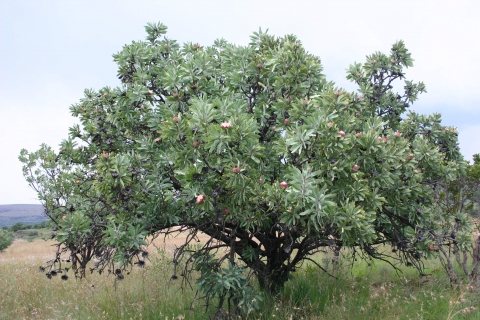Protea caffra
Meisn.
Proteaceae
Protea bolusii Phillips
Protea kilimandscharica Engl.
Protea multibracteata Phillips
Protea nyasae Rendle
Protea rhodantha Hook.f.
Common Name:

Protea caffra tree some 3 - 4metres tall, growing wild in South Africa
Photograph by: Paul venter
Creative Commons Attribution-Share Alike 3.0

Protea caffra tree some 3 - 4metres tall, growing wild in South Africa
Photograph by: Paul venter
Creative Commons Attribution-Share Alike 3.0

Plants growing in the wild
Photograph by: JMK
Creative Commons Attribution-Share Alike 3.0

Flowering branch
Photograph by: JMK
Creative Commons Attribution-Share Alike 3.0

Close-up of flower
Photograph by: JMK
Creative Commons Attribution-Share Alike 3.0
General Information
Protea caffra is an evergreen shrub or small tree. In areas subject to frequent burning it remains a shrub, growing 1.5 - 3 metres tall, but in other areas it can become a small tree with a somewhat rounded crown that can be 8 metres tall with a bole up to 40cm in diameter[
328- Title
- African Flowering Plants Database
- Publication
-
- Author
-
- Website
- http://www.ville-ge.ch/musinfo/bd/cjb/africa/recherche.php
- Publisher
- Conservatoire et Jardin Botaniques.
- Year
- 0
- ISBN
-
- Description
- Contains information on over 150,000 plant names (including synonyms) giving a description and habitat, plus a distribution map.
]. The thick bark has a chunky, corky texture which protects the mature plant from the fires that happen so commonly in the grassland where it grows.
The plant is harvested from the wild for local medicinal use.
Known Hazards
None known
Botanical References
Range
Eastern Africa - Uganda, Kenya, Tanzania, eastern DR Congo, Zambia, Malawi, Mozambique, Zimbabwe, S. Africa.
Habitat
Found in a wide range of habitats from humid, tropical coastlines to grassland and high ridges; on a variety of geological formations, favouring poor, sandy or quartzite soils, acid in nature, but also sometimes even on alkaline dolomite[
].
Properties
| Medicinal Rating |      |
| Habit | Evergreen Shrub |
| Height | 3.00 m |
| Pollinators | Birds, Bees, Beetles |
| Cultivation Status | Wild |
Cultivation Details
A plant of the subtropics to the tropics, where it is found at elevations up to 2,100 metres. It grows best in areas where annual daytime temperatures are within the range 15 - 25°c, but can tolerate 10 - 30°c[
]. It prefers a mean annual rainfall in the range 400 - 900mm, but tolerates 300 - 1,000mm[
].
The cultivation of this species has proved to be very difficult. The plant is very sensitive to root disturbance, it is best to avoid any cultivation around the base of the plant[
295- Title
- PlantZAfrica.com
- Publication
-
- Author
-
- Website
- http://www.plantzafrica.com
- Publisher
-
- Year
- 0
- ISBN
-
- Description
- An excellent site giving detailed descriptions and uses of many S. African plants.
]. Requires a sunny position[
]. Grows best in a well-drained, sandy to loamy soil of low fertility[
]. Prefers a pH in the range 5 - 7, tolerating 4.5 - 8[
]. Established plants are very drought tolerant[
].
Plants can succeed in areas where there are regular bush fires[
295- Title
- PlantZAfrica.com
- Publication
-
- Author
-
- Website
- http://www.plantzafrica.com
- Publisher
-
- Year
- 0
- ISBN
-
- Description
- An excellent site giving detailed descriptions and uses of many S. African plants.
].
The flowers are a very rich source of nectar[
].
Edible Uses
None known
Medicinal
The bark is used medicinally[
295- Title
- PlantZAfrica.com
- Publication
-
- Author
-
- Website
- http://www.plantzafrica.com
- Publisher
-
- Year
- 0
- ISBN
-
- Description
- An excellent site giving detailed descriptions and uses of many S. African plants.
].
Other Uses
None known
Propagation
Seed -
If you have any useful information about this plant, please leave a comment. Comments have to be approved before they are shown here.





 Useful Tropical Plants Database 2014 by
Ken Fern,
web interface by
Ajna Fern
with help from
Richard Morris.
Useful Tropical Plants Database 2014 by
Ken Fern,
web interface by
Ajna Fern
with help from
Richard Morris.